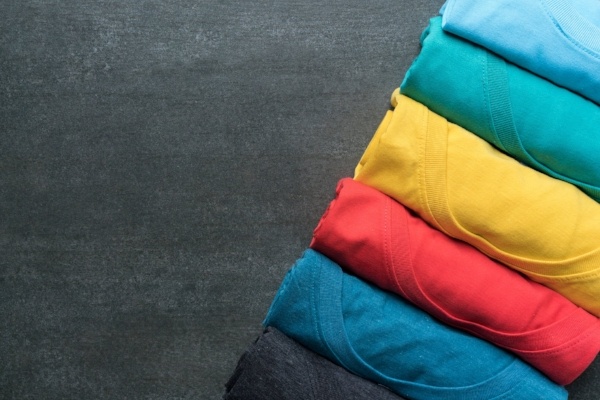Upcycle Your Planet: How to Combat Textile Waste in Style

The fashion industry is the world’s second-largest industrial polluter, second only to oil. In fact, 20% of global production waste comes from the textile and apparel sectors.
As apparel spending grows worldwide and companies that provide cheap, trendy clothing expand, the dizzying statistics related to clothing pollution will only get worse. Both production and post-consumer waste have parts to play in the rapidly changing climate. But how did it all begin? And how can we change our approach to fashion and mitigate its ill effects on our planet?
The Rise of the Fast Fashion Industry
A term coined by the New York Times back in the 1990s, fast fashion refers to clothing that zips through the design and production process in as little as 15 days. Often, that speed is reflected in its short tenure on display, as well; stores like Zara aimed to fully change the stock in their stores every three weeks.
The resources needed to achieve this type of turn-around place unnecessary strains on water sources and manpower. Yet the financial success of the model was undeniable, and other big-box stores soon followed suit. Even online stores have joined the fray, with companies like Shein and Wish driving consumers to choose the cheapest clothing option available.
The “fast” in fast fashion refers to not only the speed in production but also to the speed in style turnover. Consumers now expect new styles more often, and that demand continues to drive production—more options, quicker. But once those clothes are “out of style,” they often end up in landfills.
Why is fast fashion bad for the environment?
Garments created to satisfy the fast-fashion craze are made under unethical conditions, both environmentally and humanely. Every part of the fast fashion machine drives consumers to purchase more clothing at a frequent pace.
Plus, the rise of fast fashion means that we’re throwing out our clothes at an alarming rate. The average consumer bought 60% more clothing in 2014 than in 2000 but kept each garment half as long. Another survey found that women in the UK only wore their clothes an average of 7 times before disposing of them. Fast fashion also takes place within the system of planned obsolescence, so the clothing made falls apart sooner than clothing made before this rise in production.
As a result, over 90 million clothing items end up in landfills worldwide. 85% of all textiles make their way to landfills each year, and the carbon emissions that come from the fashion industry outweigh that of both international flights and maritime shipping.
Microplastics carry their own consequences, and as consumers wash their garments, they release harmful materials into the water supply. Microplastics also contribute to the unsafe working environment that many underpaid and overworked people are forced into in order to meet demand for new fashions. Polyester, for instance, releases a large number of microplastics when washed and produces more carbon emissions than cotton. The effects of trying to grow enough cotton to satisfy demand or of creating synthetic fibers like polyester cause toxin-leaching into the soil. These toxins can reduce fertility, biodiversity, and harm the environment.
In the realm of water use, fast fashion drains resources and pollutes a great deal of the world’s water supply. The fashion industry uses 44 trillion liters of water just for fabric crop irrigation. This excessive use of water is depleting oceans and groundwater drinking sources globally.
Sustainability in the Fashion Industry
While there is much greed and corruption within the fast fashion industry, some thought leaders and policy creators are attempting to change the status quo for clothing production. Some clothing companies and conscious environmental activists are working to achieve a carbon-neutral fashion industry, dedicated to ecological integrity, social and political justice, equality, and protection for natural resources and animals.
What is sustainable fashion?
Examples of sustainable fashion include:
- thrifting, swapping, or renting clothes
- vegan or cruelty-free clothing
- eco-friendly/green fashion
- slow fashion (which refers to a slower manufacturing process)
All of these practices go along with consumer consciousness. The consumer has a large part in the cycle. Even if the companies themselves make a lot of the decisions regarding the production process, consumers can raise their voices and put away their credit cards to show producers what they want out of their shopping experience.
Making the conscious choice to only buy ethically sourced and produced fashion helps not only the environment but also the people who work in atrocious conditions to deliver the textiles needed for fast fashion.
Fast Fashion vs. Sustainable Fashion
Where fast fashion seeks to push the consumer to buy more and more clothing at a faster pace, sustainable fashion aims to make clothes that last longer and can then be donated to thrift stores, upcycled, recycled, or traded.
The limitations of the textile recycling industry
Many see textile recycling technology as a panacea to the world’s growing apparel waste. A handful of companies, such as Econyl, Evernu, Worn Again, FABSCRAP, and HK Research Institute are developing mechanical or chemical processes to recycle textiles.
The allure of technology is understandable—it represents creativity, innovation, and the future. These days, it’s seen as the answer to every problem. If it hasn’t already provided the solution, our unyielding faith in its potential leads us to believe that it will.
This may present a problem though—particularly when it comes to the fashion industry.
At this point, there are many limitations to textile recycling technologies such as:
- The inability to separate clothes with more than two fiber types
- The difficulty in recycling clothes with more than 5% elastane (elastic)
- The size of recycled natural fibers; some are not long enough or strong enough to create an entire garment
- The high levels of chemicals and energy needed to recycle materials
As a result, it’d be naïve of us to expect that they’ll be able to process any significant amount of discarded textiles soon. It’ll be a while before textile recycling technology can catch up to the pace at which we’re currently throwing clothes away—if ever.
Reduce fashion waste by wearing clothes longer
There’s immense value loss in disposing of clothes so frequently. A recent study conducted by Fibersort and the European Regional Development Fund found that approximately 64% of post-consumer textiles are re-wearable, meaning that we’re throwing out clothes well before the end of their useful life. To give you a sense of the scale of the loss (and the size of the potential), less than 15% of the 15 million tons of used textile waste is recycled in the United States annually!
Even if textile recycling technologies were commercialized, that wouldn’t solve the number of used garments lost to downcycling and landfills each year through inefficient collection.
So what’s the answer? Purchasing fewer, higher quality clothes and wearing them longer.
As consumers, we have tremendous power to reverse these destructive trends in the fashion industry. According to the Waste & Resources Action Programme (WRAP), extending the life of clothing by an extra nine months of active use would reduce carbon, waste, and water footprints by around 20-30% each and cut resource costs by 20%.
Clothes should not have a similar lifespan as the food and beverage industry. Small changes in our behavior can change that and allow textile recycling technology to eventually catch up.
Don’t know how to shop sustainably? First, know that shopping sustainably doesn’t have to mean sacrificing style. Companies are seeking to expand their sustainable collections, so more options for fashionable sustainability are being added all the time. Another way to shop sustainably is to buy well-made products with a proven lifespan. Investing in higher quality products means you can get more wear out of it, and if you decide to donate it, those after you will also get more life out of it. When looking at the materials in your clothing, the simpler the fibers, the better. Look for clothing with natural fibers, and try to avoid the synthetic materials that release microplastics into the water.
Fashion and Sustainability Careers
If you want to see the fashion industry lean into sustainable development, lead the change yourself! You could pursue a career in rewriting the policies that fashion producers must follow to make their companies more sustainable, or you could start your own sustainable fashion company. To learn more about your options for jobs in this field, check out a clip of Bard’s webinar on careers in sustainable fashion below!
Bard College offers several graduate programs in sustainability that will prepare you for affecting real change in the sphere of sustainable fashion. Our programs include intensive courses and a 4-6 month internship with major players in sustainability circles.
If you’re interested in creating a sustainable fashion career, watch our full webinar featuring sustainable fashion industry experts.
Samuel Brundrett is a graduate student of Bard's MBA in Sustainability.





